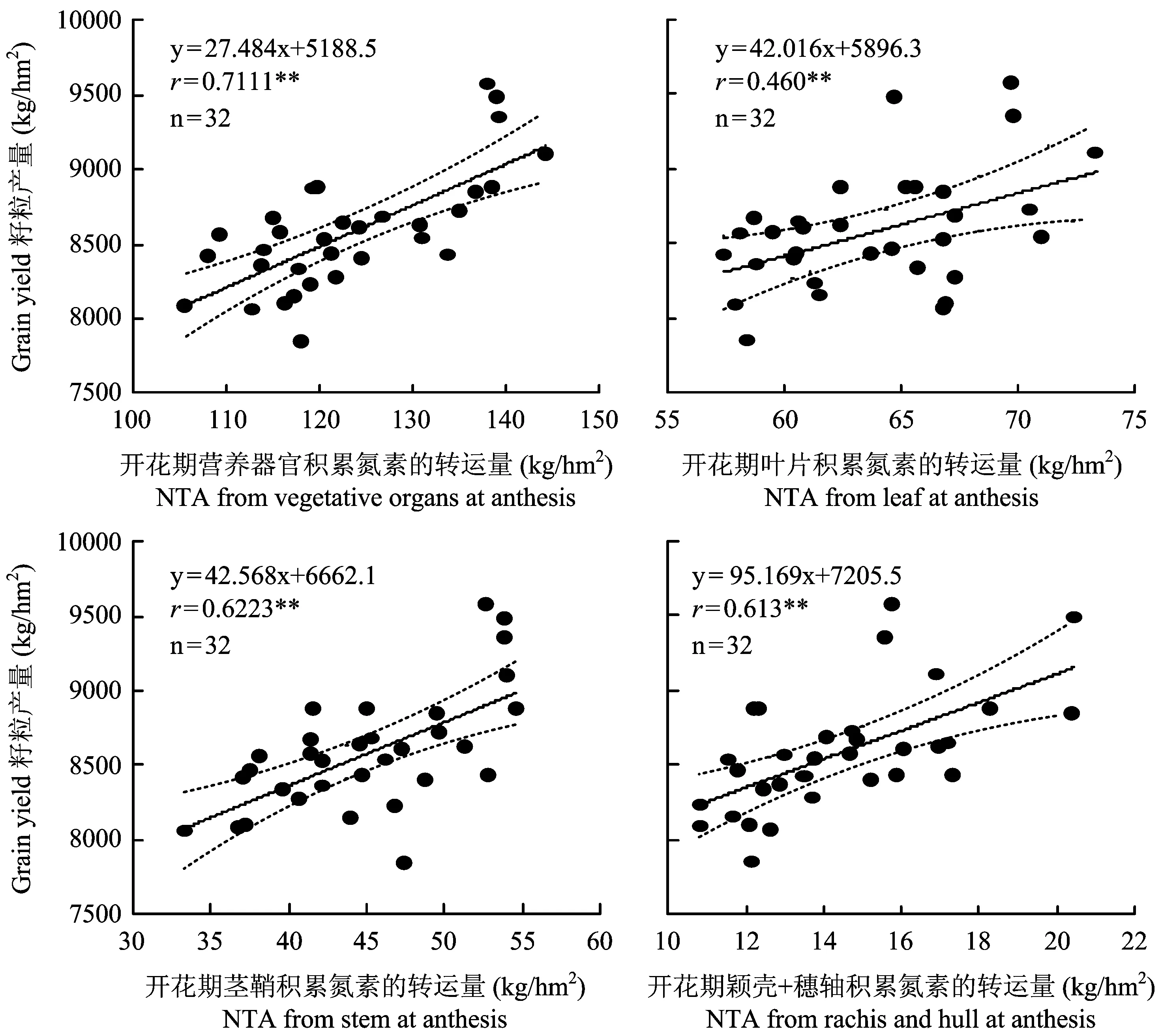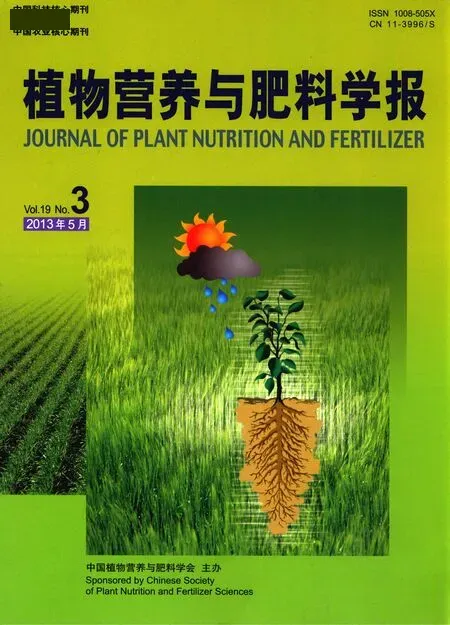稻茬小麦公顷产量9000 kg群体氮素积累、 分配与利用特性
2013-10-17丁锦峰杨佳凤王云翠陈芳芳封超年朱新开李春燕彭永欣郭文善
丁锦峰, 杨佳凤, 王云翠, 陈芳芳, 封超年, 朱新开,李春燕, 彭永欣, 郭文善
(扬州大学江苏省作物遗传生理重点实验室/农业部长江中下游作物生理生态与栽培重点开放实验室/扬州大学小麦研究所,江苏扬州 225009)
稻茬小麦公顷产量9000 kg群体氮素积累、 分配与利用特性
丁锦峰, 杨佳凤, 王云翠, 陈芳芳, 封超年, 朱新开,李春燕, 彭永欣, 郭文善*
(扬州大学江苏省作物遗传生理重点实验室/农业部长江中下游作物生理生态与栽培重点开放实验室/扬州大学小麦研究所,江苏扬州 225009)

稻茬小麦; 高产; 氮素积累、 分配与利用
Abstract: Nitrogen (N) is one of the essential nutrients for wheat production. It is very important to figure out what are the definite characteristics of N accumulation, distribution and utilization in different yield level populations, which is much theoretical and practical meaning to agricultural production. In this study, these characteristics of wheat population at yield level of 9000 kg/ha (LV. 9000) were studied by agronomic management on the medium-gluten wheat, Yangmai 20 (TriticumaestivumL.), grown in rice-wheat rotation. The field experiments were performed at 32 combinations of two planting densities (150×104and 225×104/ha) and different N managements, including N amount (210 and 262.5 kg/ha), the ratio of basis ∶tillering ∶elongation ∶late topdressing of N (3 ∶1 ∶3 ∶3 and 5 ∶1 ∶2 ∶2), and N topdressing stage (flag leaves stage, booting stage, heading stage and anthesis). The results show that the LV. 9000 N accumulation amounts (NAA) at stages from the elongation to the anthesis, at the anthesis and at the maturity are 104-117, 197-205 and 234-251 kg/ha, respectively, which are significantly higher than those of other populations. The NAAs in leaves, stems and spikes at the anthesis and in grain at the maturity are respectively significant linear positive correlation with the grain yield, and are 89-91, 74-83, 32-33 and 177-188 kg/ha under the LV. 9000. The N translocation amount (NTA) from vegetative organ at anthesis to grain is significantly linear positive correlation with grain yield. The LV. 9000 NTAs from leaves, stems, and raches and hulls at the thesis to grain are 65-73, 53-54 and 16-20 kg/ha, separately. For the LV. 9000 in rice-wheat rotation, the N amount to produce 100 kg of grain, N use efficiency and N harvest index are 2.9-3.0 kg, 32.9-34.5 kg/kg and 0.73-0.77, respectively.
Keywords: wheat in rice-wheat rotation; high-yielding; accumulation; distribution and utilization of nitrogen
不同产量水平小麦群体各生育期氮素积累量及阶段积累量存在差异[1-4]。黄淮麦区产量高于9000 kg/hm2的旱茬小麦氮素吸收与利用特性已有相关报道,张洪程等[5]认为与一般高产群体相比,9000 kg/hm2高产群体吸氮总量约增加10%,主要是生育中、 后期的吸氮量的增加; 于振文等[6]认为9000 kg/hm2高产小麦每公顷吸收氮的总量高于高产麦田,但生产100 kg籽粒所需的氮少于高产麦田; 张法全等[7]认为10000 kg/hm2小麦具有较高的植株氮素积累量、 籽粒氮素积累量和花后营养器官氮素向籽粒的转运量。长江中下游麦区稻茬小麦籽粒产量在7500 kg/hm2左右的群体氮素吸收与利用特性也已有报道[1,8-9],9000 kg/hm2高产群体的氮素积累、 分配与利用特性尚少有涉及。本研究在稻-麦两熟制条件下,以扬麦20为材料,通过基本苗和氮肥施用量、 施用时期和比例调控建立不同产量水平群体,分析不同产量水平群体氮素积累动态、 氮素吸收与利用及其与籽粒产量的关系,探讨稻茬小麦9000 kg/hm2群体的氮素积累、 分配与利用特性,为稻茬小麦大面积高产及高产栽培提供理论与实践依据。
1 材料与方法

表1 小麦不同生育期积温、 日照和降水
注(Note): S—Seeding; BW—Beginning winter stage; G—Green-turning stage; EL—Elongation stage; B—Booting stage; A—Anthesis; M—Maturity
1.1 试验设计
采用4因素裂区设计,以基本苗数为主区,设150×104plant/hm2(A1)、 225×104plant /hm2(A2)两个水平; 施氮量(纯N)为副区,设施N 210 kg/hm2(B1)、 262.5 kg/hm2(B2)两个水平; 以不同基肥 ∶壮蘖肥 ∶拔节肥 ∶穗肥为裂区,设3 ∶1 ∶3 ∶3(C1)、 5 ∶1 ∶2 ∶2(C2)两个水平; 以后期追肥时期为小裂区,设剑叶露尖(D1)、 孕穗期(D2)、 抽穗期(D3)和开花期(D4)4个水平,共32个处理。基肥于播种前施用,壮蘖肥于4叶期施用,拔节肥于叶龄余数2.5时(主茎尚有2.5张叶片未长出)施用,N ∶P2O5∶K2O为1 ∶0.6 ∶0.6,磷、 钾肥50%基施,50%于叶龄余数2.5时追施。2010年11月1日播种,人工条播,行距30 cm,3叶期定苗,小区面积为18 m2,重复3次。其余管理措施同大田高产栽培。
1.2 测定项目与方法
1.2.1氮素积累动态 分别于越冬始期、 返青期、 拔节期、 孕穗期、 开花期、 乳熟期和成熟期各小区连续取植株样20株,样品按器官分开,105℃杀青30 min, 80℃烘至恒重,测定干物重。将不同生育期植株样本烘干后磨碎,用H2SO4-H2O2消解—靛酚蓝比色法[10]测定植株样本含氮量,计算各器官氮素积累量及植株氮素积累总量。
1.2.2 产量及产量结构 成熟期在各小区调查穗数、 每穗实粒数及千粒重,每小区收获1.2 m2计产,重复三次,折算成籽粒含水率为13%时的产量。
1.3 统计分析
100kg籽粒吸氮量(kg)=植株氮素积累量/籽粒产量[11]
花后营养器官氮素转运量(kg/hm2)=开花期营养器官氮素积累量-成熟期营养器官氮素积累量[7]
氮素利用效率(kg/kg)=籽粒产量/植株氮素积累量[12]
氮素收获指数 =籽粒氮素积累量/植株氮素积累量[13]
试验数据采用SPSS 15.0软件进行统计分析,LSD法检验差异显著性。主要生育期、 生育阶段、 不同器官氮素积累量和花后氮素转运量与产量的关系采用线性方程y=ax+b进行拟合,以RMSE、 R2检验方程拟合精度,并用SigmaPlot 10.0作图。
2 结果与分析
2.1 不同产量水平群体氮素吸收积累差异



2.2 群体不同器官氮素积累、 分配和转运差异及其与产量的关系


图1 不同产量水平群体氮素积累动态Fig.1 Nitrogen accumulation amount(NAA) dynamics under different yield levels population[注(Note): BW—Beginning winter stage; G—Green-turning stage; EL— Elongation stage; B—Booting stage; A—Anthesis; MR—Milk-ripe stage; M—Maturity. 图中ns、 *、 **分别表示不同产量水平群体间差异不显著、 显著及极显著 ns, * and ** in figure are non significantly, and significantly or very significantly different at the 0.05 and 0.01 probability levels under different yield levels population.]

图2 不同生育阶段氮素积累量与籽粒产量的关系Fig.2 Relationship between NAA at different growth and development stages and yield of wheat[注(Note): NAA—Nitrogen accumulation amount. 实线为线性回归趋势线,虚线为95%置信区间Solid lines are linear regressions, dashed lines are the 95% confidence intervals.]

图3 开花期氮素在不同器官中的积累量与籽粒产量的关系Fig.3 Relationship between NAA in different organs at the anthesis and yield of wheat[注(Note): NAA—Nitrogen accumulation amount. 实线为线性回归趋势线,虚线为95%置信区间Solid lines are linear regressions, dashed lines are the 95% confidence intervals.]

图4 成熟期氮素在不同器官中的积累量与籽粒产量的关系Fig.4 Relationship between NAA in different organs at the maturity and yield of wheat[注(Note): NAA—Nitrogen accumulation amount. 实线为线性回归趋势线,虚线为95%置信区间Solid lines are linear regressions, dashed lines are the 95% confidence intervals. ]


图5 花后不同营养器官氮素的转运量与籽粒产量的关系Fig.5 Relationship between nitrogen translocation amount (NTA) from different organs to grains and yield of wheat[注(Note): NTA—N translocation amounts. 实线为线性回归趋势线,虚线为95%置信区间Solid lines are linear regressions, dashed lines are the 95% confidence intervals. ]

2.3 不同产量水平群体100 kg籽粒吸氮量、 氮素利用效率、 氮收获指数的差异
3 讨论与结论




[1] 凌启鸿. 作物群体质量[M]. 上海: 上海科学技术出版社, 2000. 17-19. Lin Q H. Crop population quality[M]. Shanghai: Shanghai Scientific & Technical Publishers, 2000. 17-19.
[2] Flowers M, Weisz R, Heiniger Retal. In-season optimization and site-specific nitrogen management for soft red winter wheat[J]. Agron. J., 2004, 96(1): 124-134.
[3] Wilhelm W W, McMaster G S, Harrell D M. Nitrogen and dry matter distribution by culm and leaf position at two stages of vegetative growth in winter wheat[J]. Agron. J., 2002, 94(5): 1078-1086.
[4] Slaton N A, Mozaffari M, DeLong R Eetal. Influence of nitrogen fertilizer application rate and time on winter wheat yields[A]. Slaton N A. Arkansas soil fertility studies 2004[C]. USA, Arkansas: University of Arkansas, 2005. 95-99.
[5] 张洪程, 许轲, 戴其根, 等. 超高产小麦吸氮特性与氮肥运筹的初步研究[J]. 作物学报, 1998, 24(6): 935-940. Zhang H C, Xu K, Dai Q Getal. Preliminary study on the traits of nitrogen absorption and nitrogen fertilizer applying in super-high-yielding winter wheat[J]. Acta Agron. Sin., 1998, 24(6): 935-940.
[6] 于振文, 田奇卓, 潘庆民, 等. 黄淮麦区冬小麦超高产栽培的理论与实践[J]. 作物学报, 2002, 28(5): 577-585. Yu Z W, Tian Q Z, Pan Q Metal. Theory and practice on cultication of super high yield of winter in the wheat fields of Yellow river and Huaihe river districts[J]. Acta Agron. Sin., 2002, 28(5): 577-585.
[7] 张法全, 王小燕, 于振文, 等. 公顷产10000kg小麦氮素和干物质积累与分配特性[J]. 作物学报, 2009, 35(6): 1086-1096. Zhang F Q, Wang X Y, Yu Z Wetal. Characteristics of accumulation and distribution of nitrogen and dry matter in wheat at yield level of ten thousand kilograms per hectare[J]. Acta Agron. Sin., 2009, 35(6): 1086-1096.
[8] 朱新开, 郭文善, 封超年, 等. 不同类型专用小麦氮素吸收积累差异研究[J]. 植株营养与肥料学报, 2005, 11(2): 148-154. Zhu X K, Guo W S, Feng C Netal. Nitrogen absorption and utilization differences among wheat varieties for different end uses[J]. Plant Nutr. Fert. Sci., 2005, 11(2): 148-154.
[9] 张铭, 蒋达, 缪瑞林, 等. 稻茬田肥力水平与施氮量对小麦籽粒产量和物质生产的影响[J]. 麦类作物学报, 2010, 30(2): 330-336. Zhang M, Jiang D, Miao R Letal. Effects of different soil fertility levels and N application rate on wheat yield and matter production after rice[J]. J. Trit. Crops, 2010, 30(2): 330-336.
[10] 吕伟仙, 葛滢, 吴建之, 等. 植物中硝态氮、 氨态氮、 总氮测定方法的比较研究[J]. 光谱学与光谱分析, 2004, 24(2): 204-206. Lü X W, Ge Y, Wu J Zetal. Study on the method for the determination of nitric nitrogen, ammoniacal nitrogen and total nitrogen in plant[J]. Spectrosc. Spectral Anal., 2004, 24(2): 204-206.
[11] 朱新开, 郭文善, 封超年, 等. 不同类型专用小麦氮肥施用参数研究[J]. 麦类作物学报, 2009, 29(2): 308-313. Zhu X K, Guo W S, Feng C Netal. Study on N application parameters in wheat for different end uses[J]. J. Trit. Crops, 2009, 29(2): 308-313.
[12] Moll R H, Kamprath E J, Kacksom W A. Analysis and interpretation of factors which contribute to efficiency of nitrogen utilization[J]. Agron. J., 1982, 74(5-6): 562-564.
[13] Timsina J, Singh U, Badaruddin Metal. Cultivar, nitrogen, and water effects on productivity, and nitrogen use efficiency and balance for rice-wheat sequences of Bangladesh[J]. Field Crops Res., 2001, 72(2):143-161.
[14] 凌启鸿, 郭文善, 彭永欣, 等. 小麦高产群体质量及其优化控制技术研究与应用研究报告[J]. 江苏农学院学报, 1995, 16(专刊): 7-51. Ling Q H, Guo W S, Peng Y Xetal. Study and application of population quality and its cultural technique in high yield wheat[J]. J. Jiangsu Agric. College, 1995, 16(suppl.): 7-51.
[15] 姜丽娜, 李春喜, 代西梅, 等. 超高产小麦氮素吸收、 积累及分配规律的研究[J]. 麦类作物学报, 2000, 20(2): 53-59. Jiang L N, Li C X, Dai X Metal. Study on the absorption, accumulation and distribution of nitrogen in super high yielding wheat[J]. J. Trit. Crops, 2000, 20(2): 53-59.
[16] 朱新开, 郭文善, 封超年, 等. 不同类型专用小麦优质高产群体氮素积累特征分析[J]. 扬州大学学报(农业与生命科学版), 2007, 28(3): 58-63. Zhu X K, Guo W S, Feng C Netal. Differences of nitrogen accumulation amount of population with high yield and good quality in wheat for different end uses[J]. J. Yangzhou Univ. (Agric. Life Sci. Ed.), 2007, 28(3): 58-63.
[17] 赵俊晔, 于振文. 高产条件下施氮量对冬小麦氮素吸收分配利用的影响[J]. 作物学报, 2006, 32(4): 484-490. Zhao J Y, Yu Z W. Effects of nitrogen fertilizer rate on uptake, distribution and utilization of nitrogen in winter wheat under high yielding cultivated condition[J]. Acta Agron. Sin., 2006, 32(4): 484-490.
[18] 许振柱, 于振文, 王东, 等. 灌溉量对小麦氮素吸收和运转的影响[J]. 作物学报, 2004, 30(10): 1002-1007. Xu Z Z, Yu Z W, Wang Detal. Effects of irrigation amount on absorbability and translocation of nitrogen in winter wheat[J]. Acta Agron. Sin., 2004, 30(10): 1002-1007.
[19] Loffler A M, Busch R H. Selection for grain protein, grain yield and nitrogen partitioning efficiency in hard red spring wheat[J]. Crop Sci., 1982, 22(3): 591-595.
[20] 童依平, 李继云, 李振声. 不同小麦品种吸收利用氮素效率的差异及有关机理研究Ⅰ: 吸收和利用效率对产量的影响[J]. 西北植物学报, 1999, 19(2): 270-277. Tong Y P, Li J Y, Li Z S. Genotypic variations for nitrogen use efficiency in winter wheat I: Effects of N uptake and utilization efficiency on grain yields[J]. Acta Bot. Bor-Occid. Sin., 1999, 19(2): 270-277.
[21] 张国平, 张光恒. 小麦氮素利用效率的基因型差异研究[J]. 植物营养与肥料学报, 1996, 2(4): 331-336. Zhang G P, Zhang G H. Studies on variation among wheat genotypes in N utilization[J]. Plant Nutr. Fert. Sci., 1996, 2(4): 331-336.
[22] 朱新开, 张旭东, 郭文善, 等. 不同品质类型小麦优质高产群体氮效率的差异[J]. 麦类作物学报, 2007, 27(6): 1070-1075. Zhu X K, Zhang X D, Guo W Setal. Differences in N efficiency of population with high yield and good quality among wheat varieties for different end use[J]. J. Trit. Crops, 2007, 27(6): 1070-1075.
Nitrogenaccumulation,distributionandutilizationcharacteristicsofwheatatyieldlevelof9000kg/hainrice-wheatrotation
DING Jin-feng, YANG Jia-feng, WANG Yun-cui, CHEN Fang-fang, FENG Chao-nian, ZHU Xin-kai, LI Chun-yan, PENG Yong-xin, GUO Wen-shan*
(KeyLaboratoryofCropGeneticsandPhysiologyofJiangsuProvince/KeyLaboratoryofCropPhysiology,EcologyandCultivationinMiddleandLowerReachesofYangtzeRiverofMinistryofAgriculture/YangzhouWheatResearchInstituteofYangzhouUniversity,Yangzhou,Jiangsu225009,China)
S512.1.01
A
1008-505X(2013)03-0543-09
2012-06-13接受日期2013-02-04
国家自然科学基金项目(30971729、 31171480); 江苏省科技厅项目(BE2009426); 江苏省农业三项工程; 江苏高校优势学科建设工程项目; 江苏高校优秀科技创新团队项目资助。
丁锦峰(1984—),男,博士研究生,主要从事作物高产栽培生理、 农业信息技术研究。E-mail:yzdingjinfeng@yahoo.com.cn * 通信作者 E-mail:wheat@yzu.edu.cn
